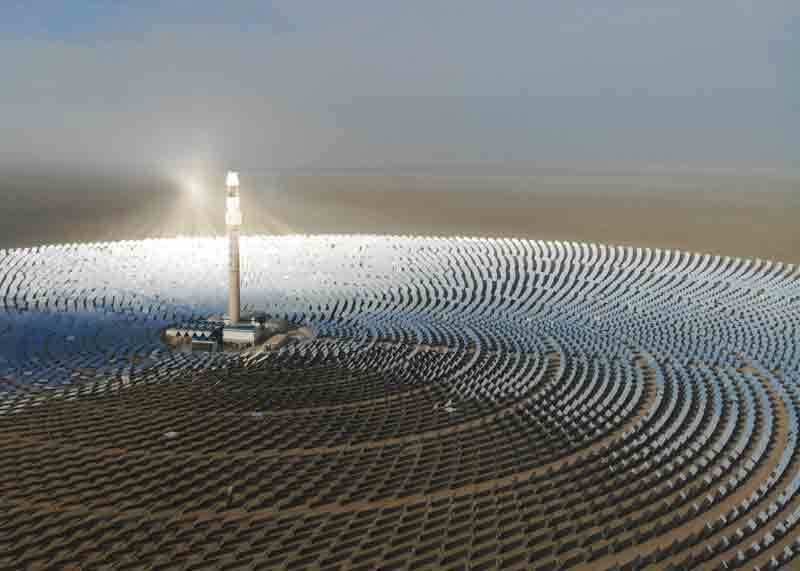
Qinghai Delingha 50MW CSP Station
When tens of thousands of heliostat track the track of the sun and complete a rotation cycle, they gather a steady stream of light and heat into the energy storage tower, thus completing the incredible transformation process from light energy to electric energy.
The sky in Qaidam was high and the clouds were light in the early winter. On November 4, the reporter saw at the site of CGN Delingha 50 MW tower type solar thermal power generation project in Delingha City, Haixi Mongols Tibetan Autonomous Prefecture. A few years ago, it was a desert, but now it is like a blue ocean against the backdrop of tens of thousands of heliostat.
“This is equivalent to the area of more than 360 standard football fields. The ‘sun island’ composed of heliostat reflects heat energy continuously to the ‘energy storage island’ in the center of the mirror field. Through the technical route of heat transfer oil heat collection, heat transfer and steam generation system, heat energy can be converted into electric energy and transmitted to the ‘power island’.” Following the direction pointed by Gao Yong, secretary of the Party branch and deputy general manager of CGN New Energy Delingha Company, A large area of strong light reflected by the heliostat converged on the towering energy storage tower, dazzling.
Solar photothermal avoids the silicon crystal photoelectric conversion process, saves energy consumption, reduces power generation costs, and truly achieves zero emissions. The annual electricity generation here can reach 200 million kilowatt hours, which can save 60000 tons of standard coal and reduce emissions of carbon dioxide and other gases by 140000 tons per year compared to thermal power plants of the same scale, equivalent to planting 280 hectares of trees.
Like large photovoltaic power plants, solar thermal power projects also require sufficient lighting and land. Due to its ability to store thermal energy, the advantages of photothermal power generation are unparalleled by other forms of solar power generation.
Eight hundred miles of vast sea and Gobi, in addition to vast land resources, there is also abundant sunshine time. According to statistical data from relevant institutions, the Qaidam Basin has sufficient sunlight, with an average annual sunshine duration of over 3500 hours and an average annual total solar radiation of 7000 megajoules per square meter. It is the second highest value area in China and truly a “sunshine zone” with significant characteristics such as high solar transmittance, long sunshine duration, and low cloud cover. The development and utilization value of solar energy is high. And under the same area and capacity conditions, photothermal power generation can generate 15% to 25% more electricity than adjacent areas.
Walking in parks and workshops… When the reporter felt the “vitality” of the towering light and heat towers in the Gobi Desert and the heliostat on one side in the desert wasteland, he could not help feeling that in the magnificent reform wave, the opportunity belonging to Qaidam had arrived.
Located in Delingha Photothermal Park, as one of the most famous business cards of the “Golden World”, there is an atmosphere of technological innovation everywhere. In addition to CGN’s slot power plant technology, tower power plant technology has also made progress, and the Zhejiang Zhongkong 50 MW tower power generation project not far from CGN’s Delingha slot power plant is also shining brightly.
Looking down from the high altitude, the heliostat field of two adjacent solar thermal power stations is like a pair of open wings, flying in pursuit of Qaidam’s “light” and “heat”.
Like trough solar thermal power generation, tower power generation also reflects the sun’s light and heat to the central energy storage tower through the heliostat. As early as 2011, when the domestic solar photovoltaic power generation market was in a wait-and-see period as a whole, Delingha was the first solar thermal power station in China – the central control Delingha 10 MW optical thermal power station, and became the first grid connected optical thermal power station in China in 2013.
The subsequent 50 megawatt tower solar thermal power generation project, as the first commercially operated solar thermal power station in China, can generate 146 million kilowatt hours of electricity with stable power output and excellent regulation performance. We have injected a continuous stream of green energy into the construction of Qinghai as a national clean energy demonstration province and the sustainable development of Haixi’s social and economic development.
The reason for choosing this place is not only due to its abundant natural resources, but also to the strong support of the government. From company registration, scientific research, environmental impact assessment, and safety assessment, to the handling of preliminary procedures, from the connection of water, electricity, road, and gas to the later operation services, the local government has opened up a green channel for us and provided one-stop services, allowing enterprises to take root here with peace of mind, “said Xu Neng, the head of Zhejiang Central Control.
According to Xu Neng, the 135 MW solar thermal power generation project with a total investment of 3.126 billion yuan has started construction this summer and is scheduled to be officially connected to the grid for power generation before September 30, 2022. At that time, it is expected to generate 435 million kilowatt hours of clean energy annually, save about 133000 tons of standard coal annually, and reduce carbon dioxide emissions by about 365000 tons.
Strengthening the development of the new energy industry cannot do without the leading role of planning. According to the plan, during the “14th Five Year Plan” period, Haixi Prefecture will focus on the goal of “carbon neutrality” and strive to increase the installed capacity of clean energy by more than 30 million kilowatts. Among them, solar thermal projects will account for “half of the new installed capacity” of new energy.
Transferred from Qinghai Daily





